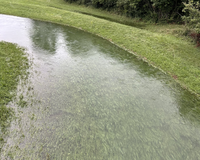
Back Règim fluvial Catalan Odtokový režim Czech Abflussregime German Régimen fluvial Spanish Jõe veerežiim Estonian Régime hydrologique French Regime fluviale Italian წყლის რეჟიმი Georgian Өзендердің қоректенуі мен режимі Kazakh Regiem (hydrologie) Dutch
Discharge regime,[1] flow regime, or hydrological regime (commonly termed river regime, but that term is also used for other measurements) is the long-term pattern of annual changes to a river's discharge at a particular point. Hence, it shows how the discharge of a river at that point is expected to change over the year.[2] The main factor affecting the regime is climate,[3] along with relief, bedrock, soil and vegetation, as well as human activity.[4]
Like general trends can be grouped together into certain named groups, either by what causes them and the part of the year they happen (most classifications) or by the climate in which they most commonly appear (Beckinsale classification).[5] There are many different classifications; however, most of them are localized to a specific area and cannot be used to classify all the rivers of the world.
When interpreting such records of discharge, it is important to factor in the timescale over which the average monthly values were calculated. It is particularly difficult to establish a typical annual river regime for rivers with high interannual variability in monthly discharge and/or significant changes in the catchment's characteristics (e.g. tectonic influences or the introduction of water management practices).
- ^ Hrvatin (1998)
- ^ "3B River Regimes". A-LEVEL GEOGRAPHY REVISION: EDEXCEL. Retrieved 2024-01-21.
- ^ Beckinsale (1969:456)
- ^ Hrvatin (1998:62)
- ^ Beckinsale (1969:460–461)


